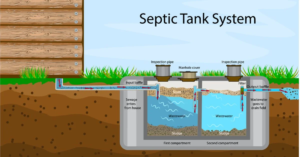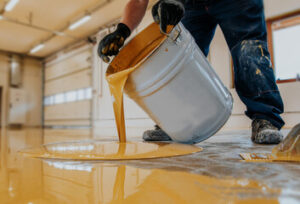Home » Articles posted by Oliver House (Page 2)
Author Archives: Oliver House
How Does a Septic Tank Work?
The septic tank serves as the first stage of treatment for wastewater in a house without a public sewer system. Gray and black wastewater from toilets, sinks, showers, and drains flow into the tank, where microorganisms break down solid waste. For more information, click the link https://www.septictankarmadale.com.au/ provided to proceed.
Heavy masses like sediment and sludge settle to the bottom, while oils and grease float to the top. The middle layer is water called effluent that is pumped out of the tank through the drain field into soil.

A septic tank is a large, watertight underground container that collects wastewater from your household. It’s the main collection point for human waste byproducts and the primary point of treatment for a home or community without a municipal sewer system.
Whenever you flush your toilet, shower or wash your clothes, wastewater flows from your plumbing into the septic tank through a sewer line that slopes down to it. The septic tank is usually made of concrete, fiberglass or polyethylene and designed to be durable enough to last for decades.
Your septic tank has one or more compartments that separate solid matter from liquid waste. Wastewater that enters your septic tank goes through a process called settling and anaerobic digestion. Solids and organic matter sink to the bottom of the septic tank, while water that contains fats, oils and other greases floats to the top. This separation is essential to the septic tank’s function because these materials can block or clog drains and sewer lines.
As the wastewater in your septic tank settles and digests, a layer of sludge forms at the bottom. A healthy population of anaerobic bacteria eats and breaks down this sludge, leaving behind a more liquid effluent. The liquid effluent then seeps through the outlet baffle, out of your septic tank and into your drain field for further treatment.
Your drain field is an area of septic tank-treated soil where clean wastewater is slowly released into the ground through perforated pipes. This soil acts as a filter, trapping any remaining solids and dispersing the liquid effluent into the groundwater below. This natural, sewage-treatment system is often used for homes in rural areas where it’s too costly to install a municipal sewer system.
Septic tanks can be made from a variety of materials, but most are constructed of concrete, fiberglass or polyethylene because these are durable and don’t crack when underground. If you’re thinking about buying a house with a septic system, be sure to ask the seller for copies of its inspection reports. Your lender will require a septic tank inspection before you’ll be allowed to close on the property.
How Does a Septic Tank Work?
A septic tank is a large, underground and watertight container that provides primary wastewater treatment. Its design allows bacteria to break down organic waste, and it pipes partially clarified effluent downstream for further treatment or final dispersal.
During the initial stage of wastewater treatment, a healthy population of anaerobic bacteria thrives inside your septic tank. These bacteria survive in an environment without oxygen and tear down a portion of the organic material. The result is a sludge layer that settles to the bottom of the tank and a liquid waste (effluent) layer that rises to the top. A septic tank inlet baffle separates the sludge and scum from the wastewater, which flows into the tank through the main sewer line from your home.
The liquid effluent passes through a vent pipe that lets out hydrogen sulfide, the toxic gas that smells like rotten eggs. A second vent pipe also releases nitrous oxides, or odorless gas, into the atmosphere. These gases must be released to prevent building pressure that could stop or reverse the flow of wastewater.
Once the septic tank is full, it drains into your septic system’s drain field, which is an area of uncovered soil that filters the effluent before it seeps into groundwater. Bacteria and other organisms in the drain field naturally break down and treat contaminants.
In addition to human feces, the septic system treats household products like toilet paper, soap, shampoo, detergents, and disinfectants. However, you should avoid flushing items that can be harmful to the septic system. This includes cooking oils, baby wipes, make-up removal wipes, feminine hygiene products, cat litter, cigarette butts, pharmaceuticals, paint thinner, and a wide range of other substances. These items can kill the bacteria that treat and digest your wastewater, leading to clogs, overflow, or even failure of your septic system. A septic inspection can identify these items and help you avoid them.
How Long Does a Septic Tank Last?
When a septic tank is properly designed, installed and serviced, it can last 40 years or more. This is especially true if the tank is made from concrete rather than plastic, which is less durable and can be susceptible to cracking over time. In general, concrete tanks are considered the best because they are very sturdy and can withstand many different environmental conditions.
The septic tank is a key part of the wastewater treatment system in your home. It holds the waste until it is able to break down naturally. After that, the septic tank will discharge a mixture of liquid and solid waste into the absorption field. This mixture is called effluent water. It is safe for the environment and your yard because it does not contain bacteria or viruses.
A septic tank can be located underground or above ground. Above-ground septic tanks are more common because they are easier to maintain and can be placed in an area that will not interfere with your yard. A septic tank should be sized to match your household’s needs, such as the number of bedrooms and toilets. The size of the septic tank will determine how much wastewater it can process and the amount of solid waste that it can hold.
Whether or not a septic tank can last for the long-term depends on several factors, including its age, how much it is used, and the habits of people living in the house, such as water usage and the flushing of non-biodegradable items. The lifespan of a septic tank can also be affected by the soil and climate where it is located.
When a septic tank is not properly maintained, it will eventually fail and result in wastewater backups into the house or into the groundwater supply. This is a serious health risk and requires expensive repairs or replacements of the entire system.
It is important to have your septic tank emptied and cleaned on a regular basis. This will help to extend its lifespan and reduce the need for expensive repairs or replacements. A septic tank should be pumped and cleaned every 3 to 5 years.
Why Do I Need to Pump My Septic Tank?
When waste enters the septic tank it begins a process known as settling. The heaviest materials, like solids and sediment, sink to the bottom of the tank where bacteria break them down into smaller particles. Fats, oils and proteins float to the top of the wastewater, forming a layer called scum. The liquid at the top of the tank is called effluent and is discharged into the drain field. The septic tank needs to be pumped when the sludge layer is within six inches of the bottom of the outlet or when the scum layer is more than 25% of the liquid depth.
Keeping up with your regular septic tank pumping schedule will increase your system’s lifespan and help you avoid costly problems. In addition to septic tank pumping, your septic system requires regular inspections to spot and repair potential issues. During these inspections, your septic service provider will check on the condition of the septic tank and the sludge and scum levels.
A full septic tank can clog the inlet and outlet tees of your septic system which will cause wastewater to back up into your home’s drains. This is a messy and expensive problem to resolve.
Another sign that your septic tank is full is when you start to notice foul odors coming from the drains in your home. If this occurs, call a septic tank professional immediately to schedule a pumping.
A good rule of thumb is to have your septic tank pumped every three to five years. If your family is large or you use more water than normal, you may need to have it pumped more often.
Septic tanks with a filter on the exit pipe can reduce the amount of solids that are discharged to your drain field. However, if you filter too frequently, you will have a septic tank with less sludge and scum to receive the maximum benefit of a properly sized septic tank.
The best way to determine how often your septic tank should be pumped is to have it inspected by a professional septic system service. The septic tank service technician will use a digital gauge to measure the level of the sludge and scum layers in your septic tank. This information will be entered into a record that will alert you when it is time to have your septic tank pumped.
